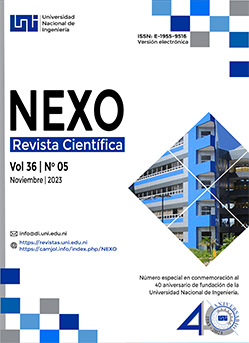Validation of chirps gauge – satellite based rainfall dataset over Nicaragua, 2011 - 2021
DOI:
https://doi.org/10.5377/nexo.v36i05.17284Keywords:
Pentadal, NSE, POD, CSIAbstract
Rainfall is a key input for many weather and climate numerical models. Therefore the strong need to have a dense enough monitoring network for this parameter. Satellite-based rainfall products have emerged in recent decades as an alternative to the more expensive gauge stations. However, a proper validation of such satellite-based products against gauge data must be performed before using their data. This study presents a validation of CHIRPS dataset against gauge data for 17 stations across Nicaragua. The performance of the product was validated at different temporal scales (daily, pentadal, monthly and annual) by different error metrics. A total of six quantitative error metrics was assessed: Bias Percentage (PBIAS), Mean Error (ME), Mean Absolute Error (MAE), Root Mean Square Error (RMSE), Pearson’s r and Nash Stucliffe Efficiency (NSE). A total three categorical indices were assessed at daily time scale: Probability of Detection (POD), False Alarm Ratio (FAR) and Critical Success Index (CSI). The results showed that CHIRPS dataset have better performance at monthly and annual time scales, while it is not capable of adequately represent the daily variability.
Downloads
405
Downloads
Published
How to Cite
Issue
Section
License
Copyright (c) 2023 Universidad Nacional de Ingeniería

This work is licensed under a Creative Commons Attribution 4.0 International License.
The authors who publish in Nexo Scientific Journal agree to the following terms:
- Authors retain the copyright and grant the journal the right of the first publication under the license Creative Commons Attribution License, which allows others to share the work with a recognition of the authorship of the work and the initial publication in Nexo Scientific Journal.
- Authors may separately establish additional agreements for the non-exclusive distribution of the version of the work published in the journal (for example, in an institutional repository or a book), with the recognition of the initial publication in Nexo Scientific Journal.
- Authors are allowed and encouraged to disseminate their works electronically (for example, in institutional repositories or in their own website) before and during the submission process, as it can lead to productive exchanges, as well as earlier and greater citation of published works.










